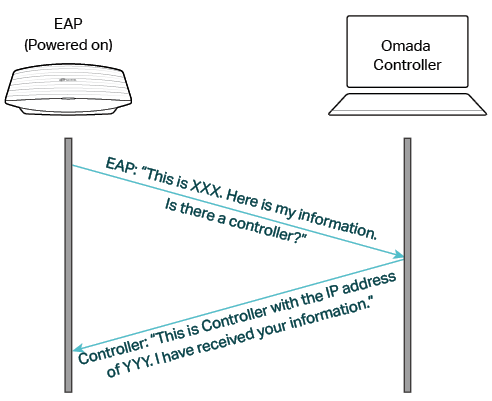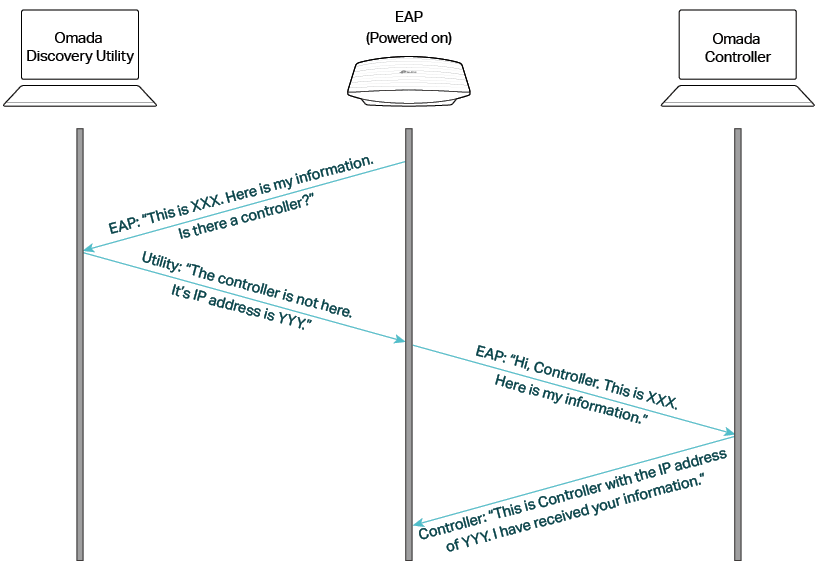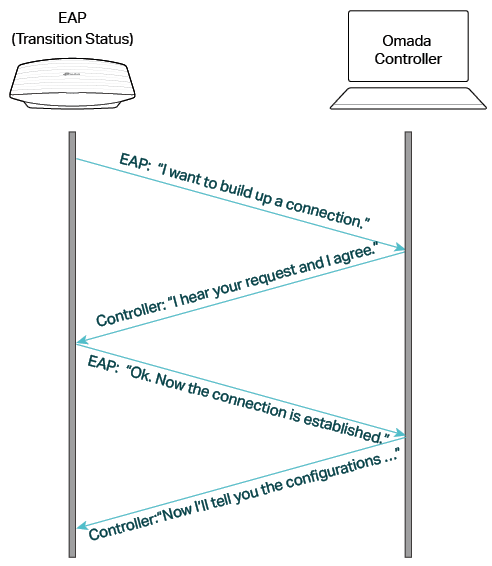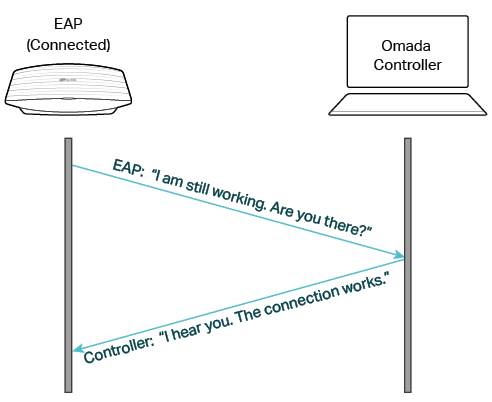Introduction of EAP Adoption
CHAPTERS
1. Changes of EAP Status During Adoption
2. Interactions During Adoption
|
|
This guide applies to: EAP110 / EAP115 / EAP225 / EAP245 / EAP320 / EAP330 / EAP115-Wall / EAP225-Wall / EAP110-Outdoor / EAP225-Outdoor / EAP Controller (Omada Software Controller) / OC200 |
EAP adoption is the first step to manage EAPs in batches. Once adopted, any changes in the management page will be applied to all managed EAPs.
This article introduces the process of EAP adoption in details, including changes of EAP status and interactions during adoption.
1Changes of EAP Status During Adoption
When adopting an EAP, the controller takes a few minutes to establish a connection with it, and then issue the configuration. During this period, the EAP entry moves from the Pending list to the Connected list, and the status of EAP changes.
The following table shows the status change of EAPs connected in two ways: the wired connection and wireless connection.
|
|
Note: Only EAPs support the mesh function can be managed via a wireless connection. Currently, EAP225-Outdoor with firmware version 1.3.0 or above and EAP225 V3 with firmware version 2.5.0 or above are available. |
Table 1-1Changes of the Status When Adopting EAPs Connected in Two Ways
|
Connection Way |
Change of Status |
|
Wired Connected |
Pending → (Provisioning) → (Configuring) → Connected |
|
Wireless Connected |
Pending |
With the status changing, the EAP changes from a Pending EAP to an adopted EAP. Statuses in the bracket are transition statuses.
The following introduces all the EAP status related to the adoption.
1.1Statuses of Pending EAPs
When an EAP is first discovered by the controller, it will be listed in the Pending list with one of the following statuses: Pending, Pending and Managed by others. Only EAPs in the status of Pending or Pending
can be adopted to the controller.
Table 1-2Statuses of Pending EAPs
|
Status |
Explanation |
|
Pending |
By default, all the EAPs with a wired network connection are in the Pending status when first discovered by Omada Controller. |
|
Pending |
The factory default EAP with mesh functions and connected wirelessly is in the Pending |
|
Managed By Others |
The EAP that has been managed by another controller before will be in the Managed By Others status if it is located on the same network as the controller. You can provide the username and password to unbind the EAP from the existing controller and begin adoption in the current controller. |
1.3Transition Statuses
Transition statuses appear briefly during the adoption, which means that the adoption goes on wheels. They are: Provisioning, Configuring, and Adopting.
Table 1-3Transition Statuses
|
Status |
Explanation |
|
Provisioning |
Provisioning is the first transition status when adopting an EAP with a wired connection. In the Provisioning status, the controller is trying to establish the connection with the EAP. |
|
Configuring |
Configuring is the second transition status when adopting an EAP with a wired connection. In the Configuring status, the controller issues configuration commands to it. |
|
Adopting |
Adopting |
1.4Statuses of Adopted EAPs
If the EAP is adopted successfully, its status will become Connected or Connected. Otherwise, the EAP will remain Pending.
Table 1-4Statuses of Adopted EAPs
|
Status |
Explanation |
|
Connected |
The EAP is connected to the network with a wired connection and can be managed by the controller. |
|
Connected |
The EAP is connected to the network wirelessly and can be managed by the controller. |
During adoption, the interaction between the EAP and controller can be divided into three steps: Discovering, Establishing and Configuring, and Maintaining.
2.1Discovering
When the EAP is powered on, it sends a message to port 29810 to broadcast its information. Once the controller receives the message, it displays the information of the EAP in the pending list and responds to the EAP with a unicast message.
The interactions are different based on different network topologies.
If the EAP is on the same subnet with the controller, the controller can receive the message directly (as shown in Figure 2-1).
Figure 2-1 Interactions During Discovering (the EAP is on the Same Subnet with the Controller)

If not, the EAP can get the IP address of the controller from EAP Discover Utility and inform the controller of its information via a unicast UDP message (as shown in Figure 2-2).
Figure 2-2 Interactions During Discovering (the EAP is on a Different Subnet with the Controller)

2.2Establishing and Configuring
Once the EAP gets the reply from the controller, it will ask to establish the connection. After that, the controller will deliver the configurations downwards to the EAP.
The following picture shows simplified interactions during Establishing and Configuring.
Figure 2-3 Interactions During Establishing and Configuring

2.3Maintaining
To maintain the connection, the EAP should send a keepalive message to the controller every 10 seconds. The following picture shows simplified interactions during Maintaining.
Figure 2-4 Interactions During Maintaining

If the EAP does not get the reply for some reasons, it will wait for 30–50 seconds and resend the keepalive message 3 times. If there is still no response, the EAP will turn back to the first step (Discovering) to get the connection again.
How to Adopt EAPs in Controller Mode?
What should I do when the controller fails to discover the EAP?
What should I do if Omada Software Controller/OC200 cannot adopt Omada EAP?